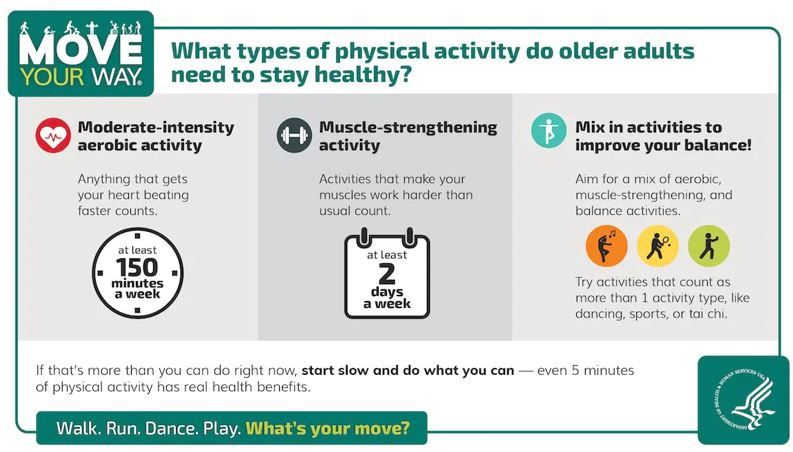HHS: Moving is Good Medicine for Adults aged 65 Years and Older
Physical activity is good medicine for patients aged 65 years and older.
The US Department of Health and Human Services (HHS) has updated its “Physical Activity Guidelines for Americans Midcourse Report: Implementation Strategies for Older Adults.”
©US Department of Health and Human Services
(See enlarged, below)

The newest guidelines do not alter the recommendations in HHS’ Physical Activity Guidelines for Americans that say adults should get at least 150 minutes of moderate-intensity aerobic physical activity and 2 days of muscle-strengthening physical activity every week.
They do emphasize the importance of physical activity for older adults, a growing population in the United States. By 2030, 1 in every 5 Americans will be aged 65 years or older, according to HHS. Currently, less than 15% of adults in this age group meet those aerobic and muscle-strengthening guidelines.
“The immediate and long-term health benefits of engaging in regular physical activity are well documented. This is why it is so important for all Americans, including older Americans, to stay physically active,” HHS Secretary Xavier Becerra said in a statement. “The Biden-Harris Administration is committed to improving the health of all Americans, no matter their age. This report will help us support older adults in living physically active lives.”
Doctors get involved
Physicians’ offices are one of 3 key settings for successful physical activity interventions, along with community locations and at home, according to HHS.
“The mindset that physical activity is an individual responsibility is shifting, and progress to ensuring all Americans have the opportunity to be physically active requires a united effort. Everyone has a role to play,” HHS Assistant Secretary for Health Adm. Rachel Levine, MD, said in a statement. “The Midcourse Report lays the foundation for a coordinated and cross-sectoral approach to make being active the easy and enjoyable choice for older adults.”
Behavior change strategies and group physical activity programs are 2 individual-level strategies that can be adapted to fit older adults’ needs or capabilities.
HHS also suggests population-level strategies involving public policies, systems, and environmental approaches that could help. For example, improving walkability of neighborhoods can make it easier and safer for anyone to walk, bike, or wheelchair roll for recreation, fitness, or to get around.
Older adults also should mix in activities to improve balance, especially with exercises that count as more than one activity type, such as dancing, sports, or tai chi.
Barriers to activity
Physicians, other clinicians, and advocates should remember older adults may face barriers to exercise, such as fear of falling, chronic health conditions, limited mobility, or pain. One of the barriers is the misperception that it is too late for patients to start gaining health benefits from physical activity, according to HHS.
“When it comes to physical activity, something is always better than nothing, and it’s important to help older adults find enjoyable and sustainable ways to build physical activity into their lifestyle,” the HHS executive summary said. To avoid injury and gain confidence, older adults should start slowly and gradually build up their levels of physical activity.
HHS also has launched the “Move Your Way” public information campaign to promote more physical activity for everyone. Free resources are available online for community planning, but they can be adapted for physicians.
